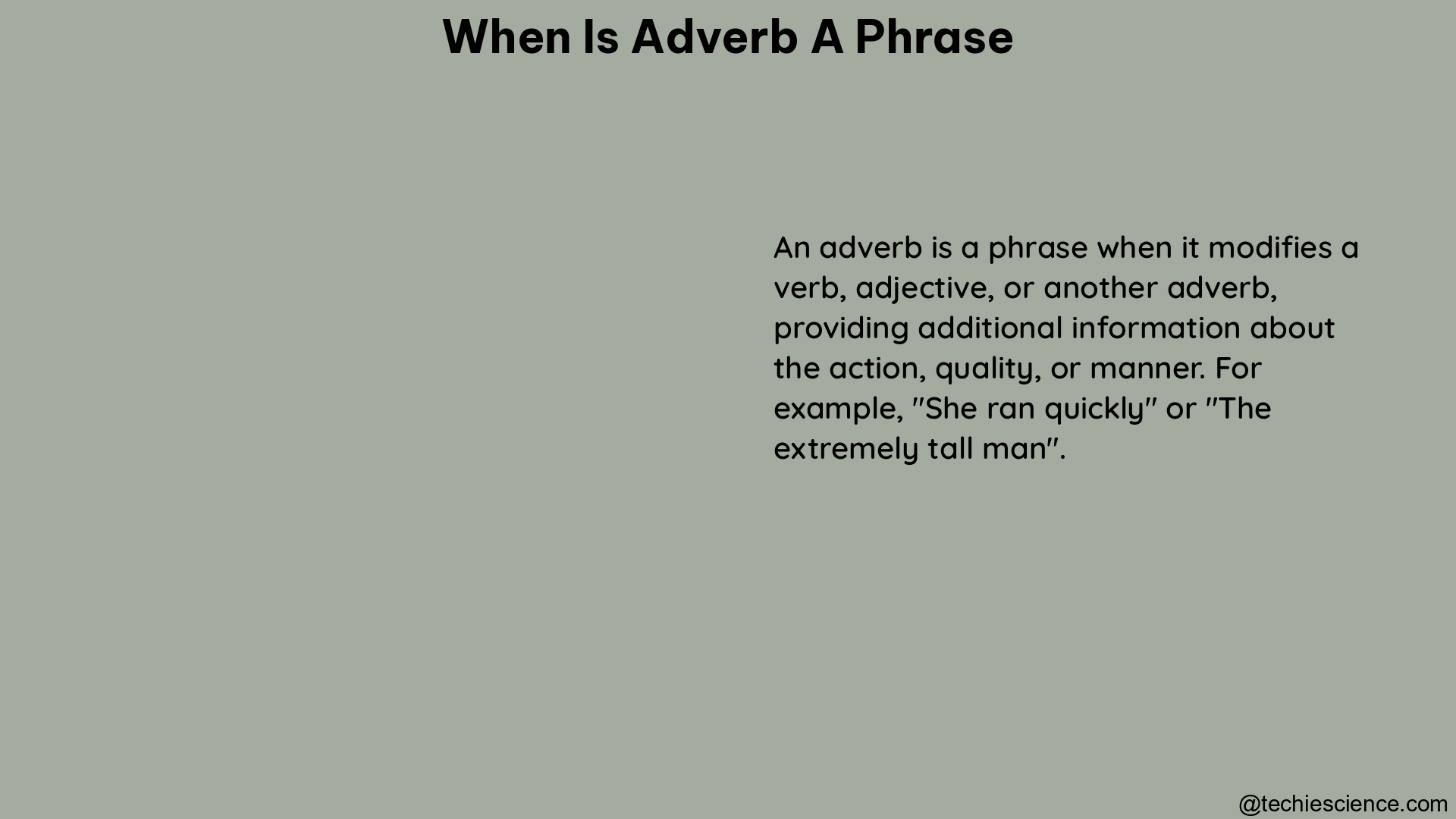An adverb is considered a phrase when it is a group of words that function together as a single adverb, modifying verbs, adjectives, or other adverbs. This phrase answers questions such as “how,” “when,” “where,” “why,” or “to what degree” an action has occurred.
Types of Adverb Phrases
Manner Adverb Phrases
Manner adverb phrases modify the way an action is performed. They answer the question “how?” Examples include:
– “with a hammer”
– “carefully and precisely”
– “in a hurried manner”
Place Adverb Phrases
Place adverb phrases modify the location of an action. They answer the question “where?” Examples include:
– “next door”
– “on the table”
– “across the street”
Time Adverb Phrases
Time adverb phrases modify the time of an action. They answer the question “when?” Examples include:
– “before the holidays”
– “every month”
– “during the summer”
Frequency Adverb Phrases
Frequency adverb phrases modify the frequency of an action. They answer the question “how often?” Examples include:
– “every month”
– “twice a week”
– “occasionally”
Purpose Adverb Phrases
Purpose adverb phrases modify the purpose of an action. They answer the question “why?” Examples include:
– “to buy a car”
– “in order to study”
– “for the purpose of learning”
Formation of Adverb Phrases

Prepositional Phrases
Adverb phrases can be formed using prepositional phrases, which consist of a preposition and a noun or pronoun. Examples include:
– “with a hammer”
– “in the morning”
– “by the window”
Infinitive Phrases
Adverb phrases can also be formed using infinitive phrases, which consist of the infinitive form of a verb. Examples include:
– “to buy a car”
– “to study hard”
– “to learn a new skill”
Adverb + Intensifier Phrases
Adverb phrases can be formed by combining an adverb and an intensifier. Examples include:
– “very carefully”
– “extremely quickly”
– “incredibly slowly”
Key Characteristics of Adverb Phrases
No Subject-Verb Element
Unlike adverb clauses, adverb phrases do not contain both a subject and a verb. They are simply a group of words that function together as a single adverb.
Modification
Adverb phrases modify verbs, adjectives, or other adverbs by answering specific questions about the action, such as how, when, where, why, or to what degree.
Grammatical Specification
Adverbial Phrases
Adverbial phrases modify the why, how, when, and where of events and actions. They provide additional information about the circumstances surrounding an action.
Adverb Clauses
Adverb clauses, on the other hand, contain a subject and a verb and modify verbs, adjectives, or other adverbs. They are more complex structures than adverb phrases.
Examples
- “I jumped over the fence to get to the other side.” (Purpose adverb phrase)
- “The carpenter hit the nail with a hammer.” (Manner adverb phrase)
- “We must finish our project before the holidays.” (Time adverb phrase)
References
- MasterClass. (2021). Adverbial Phrases Explained: How to Use Adverbial Phrases. Retrieved from https://www.masterclass.com/articles/adverbial-phrase
- University of Victoria. (n.d.). Adverb Phrases. Retrieved from https://continuingstudies.uvic.ca/elc/studyzone/410/grammar/advphr/
- Cambridge Dictionary. (n.d.). Adverb phrases. Retrieved from https://dictionary.cambridge.org/us/grammar/british-grammar/adverb-phrases
- Grossmont College. (n.d.). Adverb Phrases and Clauses. Retrieved from https://www.grossmont.edu/about-grossmont/find-people/karl-sherlock/parts-of-speech-guide/modifers/adverbs/adverb-phrases-and-clauses.php
- Vaia. (n.d.). Adverb Phrase: Differences & Examples in English Sentences. Retrieved from https://www.vaia.com/en-us/explanations/english/english-grammar/adverb-phrase/
Hi… I am Sowndharya Jagadeeswaran, a university rank holder in M.A. English Literature. I have also done my master’s in Business Administration. Inquisitive as I am, my interest in action-oriented research helped me publish research papers in reputed journals. Now, as a career, I am an instructor where I teach young and adorable students the intricate technicalities of Public Speaking and Creative Writing. I also enjoy writing articles on topics I specialize and research in.
You can connect with me through LinkedIn.-